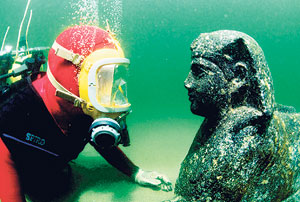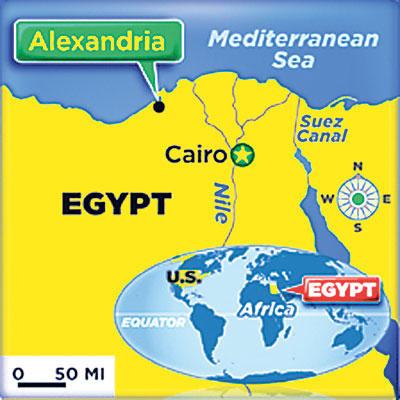Cleopatra was Egypt's last pharaoh and one of history's most famous women. Now her palace may become the world's first underwater museum.
Cleopatra ruled Egypt from the Egyptian city of Alexandria from 51 B.C., to 30 B.C. What remained of the royal city fell into the sea after a series of
earthquakes and tsunamis more than a thousand years ago.

A diver comes eye-to-eye with a sphinx made out of black granite in the harbour of Alexandria. The face of the sphinx is believed to represent Cleopatra's father, Ptolemy XII. |
The city slid into the ocean, and despite the passage of time, much of Alexandria's royal quarters were preserved in almost
perfect condition.
"It's a unique site in the world," says Franck Goddio, an underwater archaeologist. Goddio leads the high-tech team that has been exploring the palace.
Soon you may be able to see the pharaoh's
treasures in their undersea home. United Nations guidelines recommend that underwater artifacts be kept underwater to
preserve their proper place in history. So the
organization is helping Egypt plan a special
museum below the Bay of Alexandria's surface.
Huge fibreglass tunnels would allow visitors to tour Cleopatra's palace as it stands today underwater.
Jacques Rougerie, the architect designing the museum, is excited about the plans for the sunken palace. He thinks being able to see the artifacts where nature left them will be an amazing experience. "It's not like going to see a movie," says Rougerie. "It's like the astronaut who cannot share with other people what it is like to be in space."
 Underwater treasures
Before plans were started for the underwater museum, Goddio and his team spent years bringing Alexandrian artifacts back to land. Divers uncovered what is now believed to be Cleopatra's palace in 1996. Underwater treasures
Before plans were started for the underwater museum, Goddio and his team spent years bringing Alexandrian artifacts back to land. Divers uncovered what is now believed to be Cleopatra's palace in 1996.
The city was preserved so well that Goddio's team used ancient Greek
descriptions to find their way around the ruins.
What lost
treasures were
hidden beneath the waves? Goddio's team has found
artifacts of many famous events from Cleopatra's life. They believe one of the many recently discovered statues shows the face of Caesarion, son of Cleopatra and Julius Caesar. In May divers explored Cleopatra's
enormous palace, where she lived and died with Roman general Mark Antony.
Divers have also found jewellery, coins and
artwork. Many temple ruins and religious objects were uncovered from
nearby islands and
harbours, also submerged. The team discovered many small lead vessels (boats), which were buried in the ground or tossed in the water as offerings to Egyptian gods.
Researchers have even discovered pieces of the
legendary Lighthouse of Alexandria. One of the Seven Wonders of the Ancient World, the Lighthouse was one of the tallest human made
structures for centuries.
Cleopatra comes to America
Starting this month,
visitors can see the riches of Cleopatra's Alexandria at the Franklin Institute in Philadelphia. The exhibition will tour several U.S. cities over the next few years.
By Zach Jones
Scholastic News |


 Underwater treasures
Before plans were started for the underwater museum, Goddio and his team spent years bringing Alexandrian artifacts back to land. Divers uncovered what is now believed to be Cleopatra's palace in 1996.
Underwater treasures
Before plans were started for the underwater museum, Goddio and his team spent years bringing Alexandrian artifacts back to land. Divers uncovered what is now believed to be Cleopatra's palace in 1996.